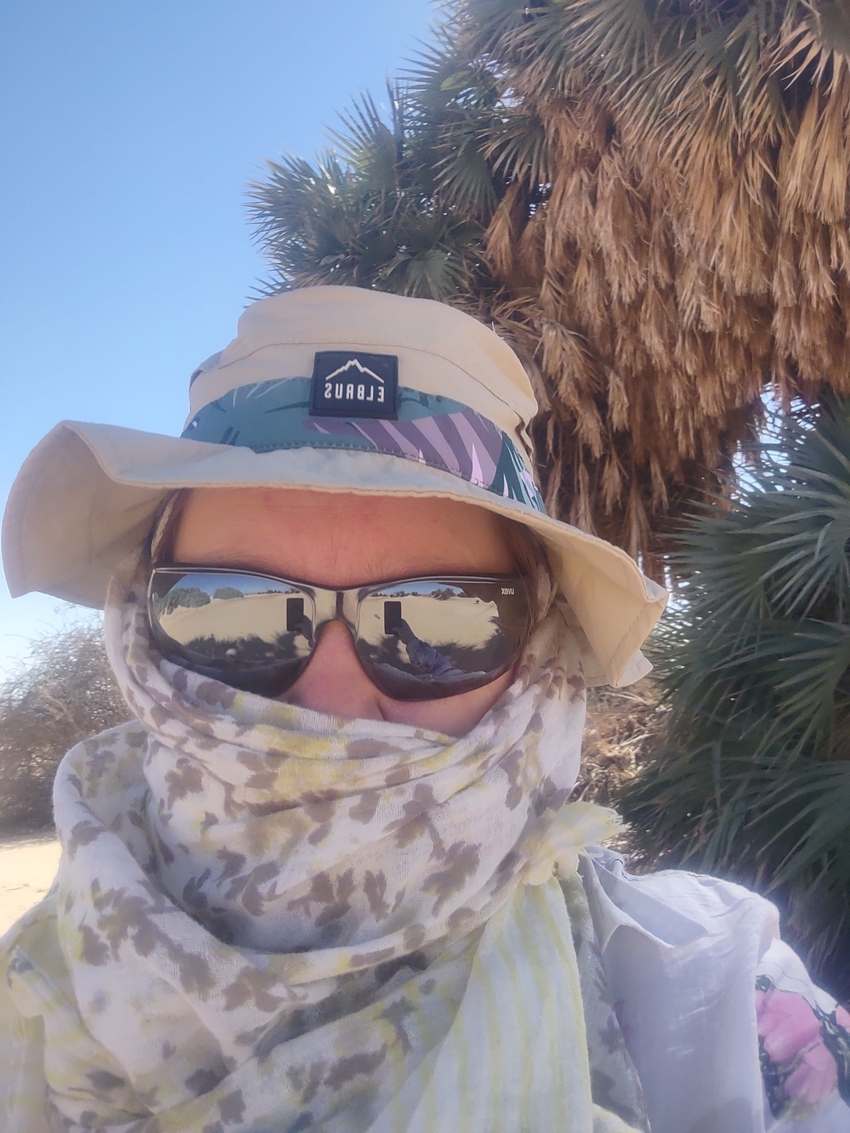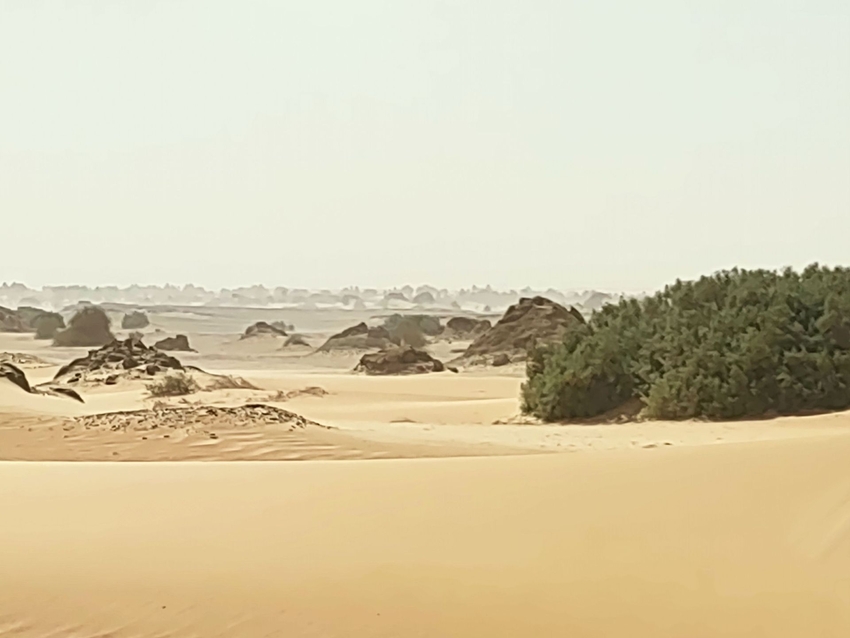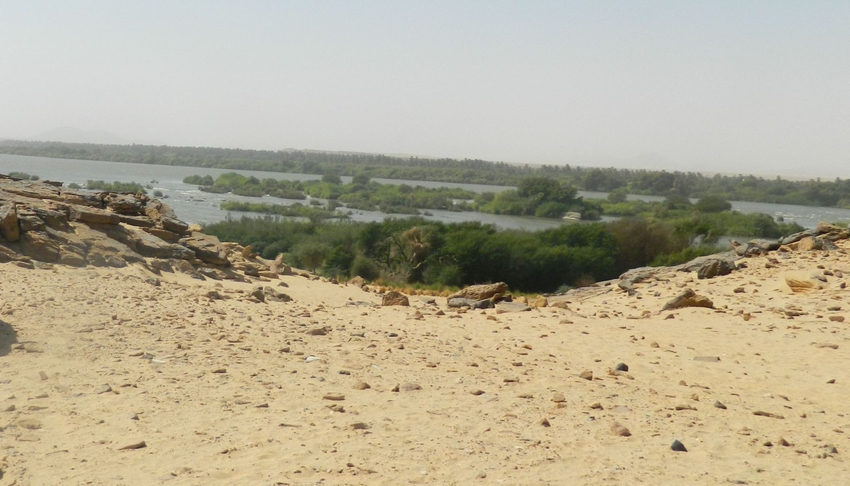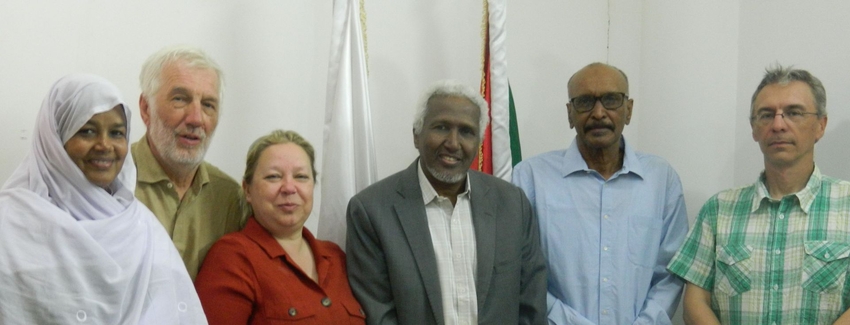Moving around Sudan required permits and involved numerous checkpoints on the main road along the Nile, which we took from Khartoum north towards the city of Dongola. Despite these restrictions and demonstrations, repeated every few days in the streets of the capital, we had the impression of peace and relative stability, supported by the conviction of our hosts that democratic forces were coming to the fore and that free elections were planned in the near future. We were fortunate to complete our trip in time to return to Poland before the civil war.
!["Kwitnąca pustynia" [Blooming desert] (photo: J. Śmiełowski) "Kwitnąca pustynia" [Blooming desert] (photo: J. Śmiełowski)](/fileadmin/_processed_/1/9/csm_Pustynia_to_nie_tylko_piach_-_fot._1._kwitn%C4%85ca_pustynia__fot._J._%C5%9Amie%C5%82owski__f3bda85f02.jpg) "Blooming desert" (photo: J. Śmiełowski)
"Blooming desert" (photo: J. Śmiełowski)
Staff members from the University of Khartoum: Prof. Dr Ikram Ahmed Madani – a botanist and an archaeobotanist, and Prof Yahia Tahir – an archaeologist and an archaeoecologist were our hosts. We represented three specialities: mycology (the expedition leader – Dr hab. Małgorzata Ruszkiewicz-Michalska, Department of Algology and Mycology, Faculty of Biology and Environmental Protection, University of Lodz), teriology and herpetology (Dr Jan Śmiełowski, an independent researcher) and entomology (Dr Radomir Jaskuła, Department of Invertebrate Zoology and Hydrobiology, Faculty of Biology and Environmental Protection, University of Lodz). Making the most of the opportunity to conduct research in such a unique area, we also collected scientific material for our faculty colleagues specialising in other groups, including algae and spiders.
 The expedition leader Dr Małgorzata Ruszkiewicz-Michalska with sunglasses and a headscarf on her face to protect against the onset of a sandstorm (photo: M. Ruszkiewicz-Michalska)
The expedition leader Dr Małgorzata Ruszkiewicz-Michalska with sunglasses and a headscarf on her face to protect against the onset of a sandstorm (photo: M. Ruszkiewicz-Michalska)
Africa, and especially its deserts, are some of the least studied areas on Earth in terms of biodiversity. Contrary to appearances, these areas are not devoid of life and the organisms that are found there are usually perfectly adapted to the extreme, inhospitable living conditions. The impetus for our expedition was the desire to explore the small hills known as tarbools found in the desert, which are formed around tamarisk shrubs that trap sand carried by the wind. They form remarkable, long-lived islands of life in the inhospitable desert landscape of the El-Ga'ab depression.
 Live and dead (wind-eroded) tarbools; an approaching sandstorm visible on the horizon (photo: M. Ruszkiewicz-Michalska)
Live and dead (wind-eroded) tarbools; an approaching sandstorm visible on the horizon (photo: M. Ruszkiewicz-Michalska)
They are quite well known to Sudanese archaeologists, as tamarisk shrubs have accompanied human settlements since prehistoric times and remains in the form of pottery and simple tools are still found around these formations today. They attracted the interest of botanists a few years ago but had never before been studied by biologists working on other groups of organisms. Although the hills are built by just one plant species, our research has confirmed that there are quite a few other organisms associated with them – fungi, invertebrates, small mammals, lizards and birds.
Sudan is not just a desert. During our short trip, we did not manage to visit many biologically promising sites, such as the rocky areas near the Red Sea and the forested areas of Al Dinder National Park on the south-east of Sudan. However, an idea of their potential was given by the observations we made in the area of the Third Cataract on the Nile, the northernmost point we reached. From this point onwards, the landscape changed, not only due to the availability of water and increased air moisture but also because of rock formations and mosaics of habitats promising greater biodiversity.
 Third Cataract on the Nile (photo: J. Smiełowski)
Third Cataract on the Nile (photo: J. Smiełowski)
Specialists from Lodz and Poznan have been working on our scientific collections in the form of specimens of fungi, plants, algae, insects, spiders, small mammals, lizards and owl pellets, as well as soil for three months. In view of the diversity and unexpectedly large number of the collected samples, we still have a lot of work ahead of us before we can present analyses and synthetic findings from this expedition.
This expedition, co-financed by the University of Lodz, was made possible thanks to the substantive and organisational support of Prof. Ikram Ahmed Madani and Prof. Yahia Tahir, personal contacts and a mutual willingness to cooperate, which we planned to develop into a long-term and institutional cooperation. An official meeting at the University of Khartoum's International Relations Office served this purpose.
 Visit by the representatives of #UniLodz and University of Chartoum to the International Relations Office (photo: M. Łaptaś) from left to right Prof. Dr Ikram Ahmed Madani, Dr Jan Śmiełowski, Dr hab. Małgorzata Ruszkiewicz-Michalska, Prof. Dr Tarig Mohamed Nour Ali, Prof. Yahia Tahir, Dr Radomir Jaskuła
Visit by the representatives of #UniLodz and University of Chartoum to the International Relations Office (photo: M. Łaptaś) from left to right Prof. Dr Ikram Ahmed Madani, Dr Jan Śmiełowski, Dr hab. Małgorzata Ruszkiewicz-Michalska, Prof. Dr Tarig Mohamed Nour Ali, Prof. Yahia Tahir, Dr Radomir Jaskuła
The dramatic political turmoil gripping Sudan is preventing this plan from being realised at the moment, making the scientific material we have brought with us particularly valuable. However, we hope that this war will not continue and destroy Sudan for long, that smiles will return to the faces of the Sudanese people and the peace of mind that has been an integral part of our daily field trips will return to their lives. We hope our friends Ikram and Yahia will return to their homes and work, to their passions and... to normality.
Source: Faculty of Biology and Environmental Protection, University of Lodz
Photos: Dr Jan Śmiełowski, Dr hab. Małgorzata Ruszkiewicz-Michalska, M. Łaptaś
Text: Dr hab. Małgorzata Ruszkiewicz-Michalska


